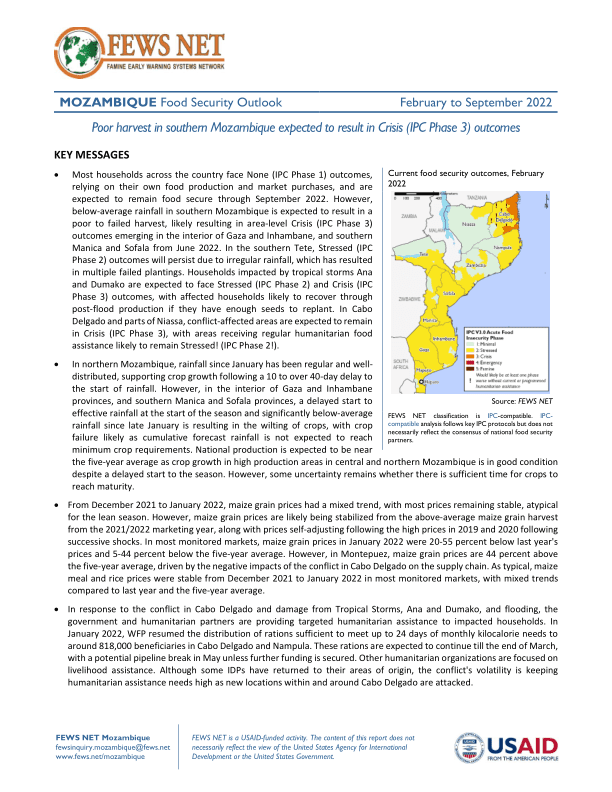Poor harvest in southern Mozambique expected to result in Crisis (IPC Phase 3) outcomes
key messages
-
Most households across the country face None (IPC Phase 1) outcomes, relying on their own food production and market purchases, and are expected to remain food secure through September 2022. However, below-average rainfall in southern Mozambique is expected to result in a Poor to failed harvest, likely resulting in area-level Crisis (IPC Phase 3) outcomes emerging in the interior of Gaza and Inhambane, and southern Manica and Sofala from June 2022. In the southern Tete, Stressed (IPC Phase 2) outcomes will persist due to irregular rainfall, which has resulted in multiple failed plantings. Households impacted by tropical storms Ana and Dumako are expected to face Stressed (IPC Phase 2) and Crisis (IPC Phase 3) outcomes, with affected households likely to recover through post-flood production if they have enough seeds to replant. In Cabo Delgado and parts of Niassa, conflict-affected areas are expected to remain in Crisis (IPC Phase 3), with areas receiving regular humanitarian food assistance likely to remain Stressed! (IPC Phase 2!).
-
In northern Mozambique, rainfall since January has been regular and well-distributed, supporting crop growth following a 10 to over 40-day delay to the start of rainfall. However, in the interior of Gaza and Inhambane provinces, and southern Manica and Sofala provinces, a delayed start to effective rainfall at the start of the season and significantly below-average rainfall since late January is resulting in the wilting of crops, with crop failure likely as cumulative rainfall forecast is not expected to reach minimum crop requirements. National production is expected to be near the five-year average as crop growth in high production areas in central and northern Mozambique is in good condition despite a delayed start to the season. However, some uncertainty remains as to whether there is sufficient time for crops to reach maturity.
-
From December 2021 to January 2022, maize grain prices had a mixed trend, with most prices remaining stable, atypical for the lean season. However, maize grain prices are likely being stabilized from the above-average maize grain harvest from the 2021/2022 marketing year, along with prices self-adjusting following the high prices in 2019 and 2020 following successive shocks. In most monitored markets, maize grain prices in January 2022 were 20-55 percent below last year’s prices and 5-44 percent below the five-year average. However, in Montepuez, maize grain prices are 44 percent above the five-year average, driven by the negative impacts of the conflict in Cabo Delgado on the supply chain. As typical, maize meal and rice prices were stable from December 2021 to January 2022 in most monitored markets, with mixed trends compared to last year and the five-year average.
-
In response to the conflict in Cabo Delgado and damage from Tropical Storms, Ana and Dumako, and flooding, the government and humanitarian partners are providing targeted humanitarian assistance to impacted households. In January 2022, WFP resumed the distribution of rations sufficient to meet up to 24 days of monthly kilocalorie needs to around 818,000 beneficiaries in Cabo Delgado and Nampula. These rations are expected to continue till the end of March, with a potential pipeline break in May unless further funding is secured. Other humanitarian organizations are focused on livelihood assistance. Although some IDPs have returned to their areas of origin, the conflict’s volatility is keeping humanitarian assistance needs high as new locations within and around Cabo Delgado are attacked.

